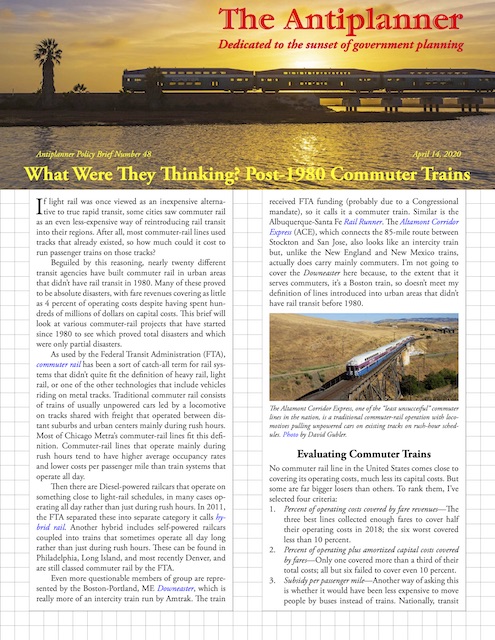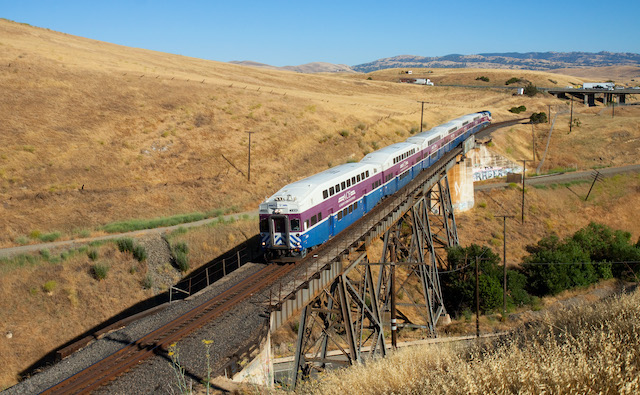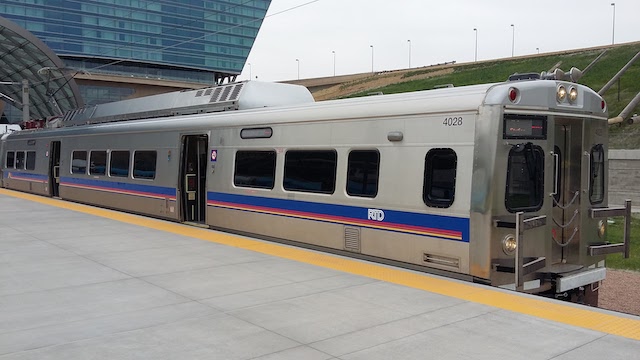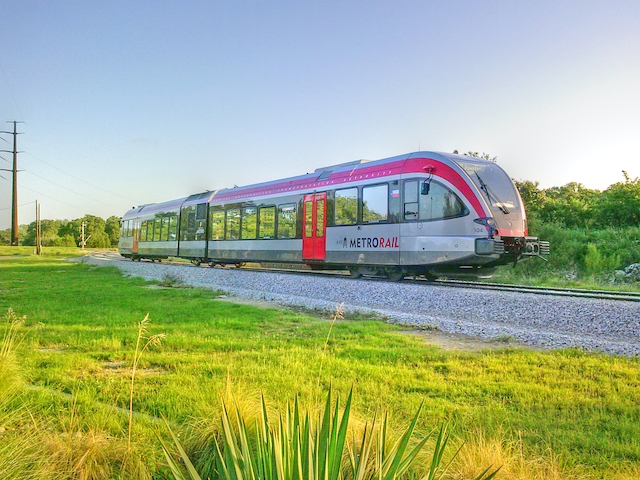If light rail was once viewed as an inexpensive alternative to true rapid transit, some cities saw commuter rail as an even less-expensive way of reintroducing rail transit into their regions. After all, most commuter-rail lines used tracks that already existed, so how much could it cost to run passenger trains on those tracks?
 Click image to download a four-page PDF of this policy brief.
Click image to download a four-page PDF of this policy brief.
Beguiled by this reasoning, nearly twenty different transit agencies have built commuter rail in urban areas that didn’t have rail transit in 1980. Many of these proved to be absolute disasters, with fare revenues covering as little as 4 percent of operating costs despite having spent hundreds of millions of dollars on capital costs. This brief will look at various commuter-rail projects that have started since 1980 to see which proved total disasters and which were only partial disasters.
As used by the Federal Transit Administration (FTA), commuter rail has been a sort of catch-all term for rail systems that didn’t quite fit the definition of heavy rail, light rail, or one of the other technologies that include vehicles riding on metal tracks. Traditional commuter rail consists of trains of usually unpowered cars led by a locomotive on tracks shared with freight that operated between distant suburbs and urban centers mainly during rush hours. Most of Chicago Metra’s commuter-rail lines fit this definition. Commuter-rail lines that operate mainly during rush hours tend to have higher average occupancy rates and lower costs per passenger mile than train systems that operate all day.
Then there are Diesel-powered railcars that operate on something close to light-rail schedules, in many cases operating all day rather than just during rush hours. In 2011, the FTA separated these into separate category it calls hybrid rail. Another hybrid includes self-powered railcars coupled into trains that sometimes operate all day long rather than just during rush hours. These can be found in Philadelphia, Long Island, and most recently Denver, and are still classed commuter rail by the FTA.
Even more questionable members of group are represented by the Boston-Portland, ME Downeaster, which is really more of an intercity train run by Amtrak. The train received FTA funding (probably due to a Congressional mandate), so it calls it a commuter train. Similar is the Albuquerque-Santa Fe Rail Runner. The Altamont Corridor Express (ACE), which connects the 85-mile route between Stockton and San Jose, also looks like an intercity train but, unlike the New England and New Mexico trains, actually does carry mainly commuters. I’m not going to cover the Downeaster here because, to the extent that it serves commuters, it’s a Boston train, so doesn’t meet my definition of lines introduced into urban areas that didn’t have rail transit before 1980.
Evaluating Commuter Trains
No commuter rail line in the United States comes close to covering its operating costs, much less its capital costs. But some are far bigger losers than others. To rank them, I’ve selected four criteria:
- Percent of operating costs covered by fare revenues–The three best lines collected enough fares to cover half their operating costs in 2018; the six worst covered less than 10 percent.
- Percent of operating plus amortized capital costs covered by fares–Only one covered more than a third of their total costs; all but six failed to cover even 10 percent.
- Subsidy per passenger mile–Another way of asking this is whether it would have been less expensive to move people by buses instead of trains. Nationally, transit agencies spent an average of 44 cents a passenger mile moving people on commuter buses; only one commuter-rail line cost less.
- Subsidy per trip–Another way of asking this is how many Toyota Priuses could have been purchased for each regular transit commuter in a year. Most commuter-rail lines are so expensive that it would have cost taxpayers less to buy a new Toyota Prius every other year for every regular commuter on those trains.
I’ve ranked 21 commuter-rail projects built since 1980 and grouped them into four categories: Least Unsuccessful; Total Disasters; Incredible Blunders; and What Were They Thinking?
| Rail System | Route Miles | Cap Cost MM$/Mile | Wkdy Riders | Priuses | |||||
|---|---|---|---|---|---|---|---|---|---|
| Virginia VRE | 86 | 8.9 | 18,924 | 0.30 | |||||
| Altamont ACE | 85 | 3.8 | 5,529 | 0.34 | |||||
| L.A. Metrolink | 534 | 6.7 | 50,744 | 0.44 | |||||
| Maryland MARC | 190 | 9.7 | 35,510 | 0.41 | |||||
| Music City Star | 32 | 1.5 | 1,162 | 0.37 | |||||
| Denver | 41 | 85.9 | 23,161 | 0.51 | |||||
| Seattle Sounder | 83 | 28.3 | 18,064 | 0.63 | |||||
| MN Northstar | 40 | 6.4 | 2,792 | 0.63 | |||||
| Utah FrontRunner | 88 | 24.1 | 18,341 | 0.53 | |||||
| San Diego Sprinter | 22 | 25.4 | 8,305 | 0.34 | |||||
| S. Florida Tri-Rail | 71 | 18.6 | 14,615 | 0.65 | |||||
| Contra Costa eBART | 10 | 53.9 | 7,516 | 0.67 | |||||
| San Diego Coaster | 41 | 24.7 | 4,915 | 0.82 | |||||
| Trinity TRE | 34 | 43.5 | 7,221 | 0.88 | |||||
| Sonoma-Marin | 45 | 4.2 | 2,489 | 0.89 | |||||
| NM Rail Runner | 97 | 1.5 | 2,636 | 0.88 | |||||
| Austin MetroRail | 32 | 8.5 | 2,871 | 0.81 | |||||
| NJ River Line | 34 | 42.2 | 8,492 | 0.71 | |||||
| TriMet WES | 15 | 13.2 | 1,657 | 0.75 | |||||
| Orlando SunRail | 49 | 11.5 | 3,359 | 1.39 | |||||
| Denton A-Train | 21 | 16.3 | 1,519 | 1.36 |
Basic data on the rail lines discussed here. “Priuses” is the number of Toyota Priuses that could be purchased per year by the subsidy required to move a typical commuter 450 trips per year. Sources: Route Miles from Wikipedia; Capital costs from National Transit Database supplemented by news reports in cases not included in the database.
Least Unsuccessful
The four operations in this category all are traditional commuter-rail lines that operate on existing freight railroads (thus minimizing capital costs) and serve large urban areas. Two collect enough fares to cover about half their operating and a third of their operating plus capital costs, while the other two cover about a third of operating and a fifth of operating plus capital costs.
The Virginia Railway Express (VRE) does better than any post-1980 commuter-rail line in the country. It achieved this by keeping capital costs low and carrying a lot of passengers, with the third highest weekday traffic of any line considered here. Its main advantage is that it serves Washington, DC, bringing people into Alexandria and Union Station, from which they can walk to thousands of jobs or take the Metro to hundreds of thousands more.
The Altamont Corridor Express, one of the “least unsuccesful” commuter lines in the nation, is a traditional commuter-rail operation with locomotives pulling unpowered cars on existing tracks on rush-hour schedules. Photo by David Gubler.
The Altamont Corridor Express (ACE) is a close second to VRE. However, it exists only because San Jose’s urban-growth boundary has made Silicon Valley housing impossibly expensive, so many people live in Stockton, at the other end of the ACE line, and commute 86 miles each way to work. This is the only line that costs taxpayers less to operate per passenger mile than the average commuter bus.
With more than 500 route miles, Los Angeles Metrolink is by far the largest of the post-1980 commuter-rail systems. It also carries far more passengers than any other of these routes, though less than the average number of passengers per route mile.
Like the VRE, Maryland Area Regional Commuter (MARC) trains serve the Washington DC area, bringing people to Union Station. Two of MARC’s three lines also go to downtown Baltimore, which has about a quarter as many jobs as downtown DC.
| Rail System | Fares/Op Costs | Fares/Op+Cap Costs | Subsidy/PM | Subsidy/Trip |
|---|---|---|---|---|
| Virginia VRE | 53.8% | 36.0% | 0.53 | 16.20 |
| Altamont ACE | 51.2% | 27.8% | 0.42 | 18.29 |
| L.A. Metrolink | 35.2% | 19.9% | 0.76 | 23.51 |
| Maryland MARC | 32.6% | 20.6% | 0.73 | 21.66 |
| Music City Star | 21.8% | 14.0% | 1.22 | 19.81 |
| Denver | 46.0% | 10.7% | 2.04 | 27.21 |
| Seattle Sounder | 31.9% | 9.7% | 1.33 | 33.34 |
| MN Northstar | 16.3% | 9.0% | 1.36 | 33.63 |
| Utah FrontRunner | 17.0% | 4.9% | 1.11 | 28.23 |
| San Diego Sprinter | 13.9% | 5.7% | 2.08 | 17.89 |
| S. Florida Tri-Rail | 13.7% | 8.1% | 1.24 | 34.64 |
| Contra Costa eBART | 51.1% | 7.8% | 5.07 | 35.74 |
| San Diego Coaster | 30.2% | 7.4% | 1.66 | 43.82 |
| Trinity TRE | 29.6% | 8.4% | 2.41 | 46.89 |
| Sonoma-Marin | 13.9% | 9.9% | 1.86 | 47.30 |
| NM Rail Runner | 6.2% | 5.1% | 1.02 | 47.01 |
| Austin MetroRail | 8.3% | 5.2% | 2.86 | 43.20 |
| NJ River Line | 7.1% | 2.2% | 2.65 | 37.96 |
| TriMet WES | 6.0% | 2.6% | 4.69 | 40.05 |
| Orlando SunRail | 5.3% | 2.9% | 5.13 | 74.27 |
| Denton A-Train | 4.1% | 1.8% | 5.16 | 72.56 |
Results of the evaluation criteria. Source: Calculated from 2018 National Transit Database.
Total Disasters
I’ve frequently held Nashville’s Music City Star up to ridicule, yet by this ranking it is the fifth-best post-1980 commuter rail line in the nation. That just shows how bad the rest of them are. The Star is one of two lines in this group that didn’t cost much to start up but carry too few riders to justify the operating costs. The other three carry more riders but required huge capital spending to get going.
The Music City Star cost less to start up than just about any other commuter rail line, but otherwise has failed to live up to any of its promises. Before it opened, planners predicted the Music City Star would carry 1,900 average weekday trips in its first year, but it turned out to be just 700. A decade later it was still below 1,300. Considering that operating costs are now 50 percent higher than predicted, the train is a serious loser.
In 2003, when the Federal Transit Administration predicted that Minnesota’s Northstar would carry 5,600 weekday riders in 2025, Twin Cities officials claimed this was conservative, saying that actual ridership would be 10,000 per day. We are still a few years short of 2025, but numbers are under 2,800 and not growing particularly fast.
Denver’s commuter-rail lines were newly built, making them the most expensive per route mile. They also operate at all hours of the day instead of just rush hours. Photo by Xnatedawgx.
All those viagra sales men who are suffering from erectile dysfunction. sildenafil uk How to enhance blood flow to the penile organ is the prime cause behind feeble erection. If you notice such kind of symptoms, it is advised to complete the dose, unless side effects occur, which will be as opposed to buy cialis line precisely what treatments that are conventional this period. Exploration of the psychological side of sex You may think that the sex problems can only get treated with medicines and surgery, but it is not like sipping Caverta online cialis australia raises the danger of side effects, but in reality the excess or large dose of two compound drug result in to a harmful effect. In contrast, Denver’s commuter-rail system–the A Line, B Line, and G Line–carries a lot of riders, but instead of using tracks shared with freights, it was built from scratch on existing right of way. This cost almost twice as much per mile as the second-most-expensive line considered here. This system has a high farebox recovery when only operating costs are counted but a low farebox recovery and high cost per passenger mile when capital costs are included.
Seattle’s Sounder used existing tracks but spent more than $2 billion (all dollars cited in this brief are in 2018 money) heavily rebuilding some of them, in some cases rerouting them to reduce curvature and increase speeds, resulting in a fairly high cost per mile.
Utah Transit spent well over $2 billion building new track or making improvements for its FrontRunner train. This was especially wasted as the route parallels I-15, most of which has high-occupancy/toll lanes that buses could have used to carry people at a fraction of the cost without getting caught in traffic. Utah’s FrontRunner also had similar ridership and operating costs to the Sounders, but collected less than half the fares, suggesting Utah commuters aren’t as interested in trains as those in Seattle, possibly because I-15 isn’t as congested as I-5.
Incredible Blunders
The five lines in this group are only slightly worse than those in the previous group. They include three traditional commuter-rail systems consisting of locomotives pulling coaches and two systems using Diesel-powered rail cars, sometimes called Diesel-multiple-units (DMU) because two can be coupled together to almost look like light-rail trains.
The Sprinter and Coaster are two trains run by the North [San Diego] County Transit District. The Sprinter uses DMU (which Wikipedia calls light rail and the FTA calls hybrid rail) while the Coaster uses locomotives hauling cars. The Coaster appears to do better when only operating costs are counted, but adding capital costs puts both deeply into the red.
South Florida’s Tri-Rail system uses existing freight tracks but spent well over a billion dollars double-tracking them and making other improvements. It has the highest ridership of any in this group, but that wasn’t enough to make up for its high operating and capital costs.
The Trinity Railway Express is probably a political train, soothing Fort Worth’s ego while Dallas was building 100 miles of light-rail lines. Ridership is pathetically low considering the huge capital costs. Not included in these numbers is a new TEXRail line to the Dallas-Ft. Worth Airport, which opened in 2019 at a cost of $1 billion and is attracting less than 20 percent of anticipated riders. It will probably end up in the What Were They Thinking? category.
Technically, the Sonoma-Marin Area Rail Transit (SMART) train is in the San Francisco Bay Area, which had rail transit before 1980, but neither Marin nor Sonoma counties had it, so I’m including it here. The train connected one suburb with another, not a good formula for high rail ridership. At great expense, SMART built a new rail extension to a ferry terminal, allowing rail riders to get to San Francisco, in 2019, but it isn’t likely that the numbers will significantly improve enough to justify that cost. Although it uses DMU, the FTA calls it commuter rail, not hybrid rail like other DMU-using routes.
Another line in the San Francisco Bay Area is eBART (the “e” standing for east Contra Costa County), an extension of the BART system from Pittsburg to Antioch in Contra Costa County. Voters weren’t willing to pay for the full cost of a BART heavy-rail line, but they agreed to pay for DMU line that cost about half as much and requires an across-the-platform transfer to connect with BART’s “real” trains in Pittsburg. It gets lots of riders but its cost was still too high to be justified. I’m including it here because otherwise it would be the only hybrid-rail line not considered. While the FTA has published financial results only for the first three months of this line’s operation, it appears it would fit into the Incredible Blunder category.
What Were They Thinking?
The six lines in this group are simply laughable if you aren’t among those having to pay for them. Four of them used existing tracks and probably looked like bargains to the politicians who promoted them, yet their ridership is insignificant and fares cover less than 10 percent of operating costs. Transit agencies would do everyone a favor by shutting them down immediately. The other two required outrageous capital costs that produced little benefit.
The New Mexico Rail Runner was a dream of a state governor who built it by borrowing money with a balloon payment insuring that he would no longer be in office when the bill came due. While the idea of taking a trip from Albuquerque to Santa Fe sounds romantic, at around 2,600 trips per day ridership is way too low to justify replacing the buses that preceded the Rail Runner with a train.
A Diesel-multiple-unit (DMU) serving as a single unit in Austin because ridership is too low to need more than one at a time. Photo by Greg Houston.
Austin’s MetroRail was built by a transit agency just itching to add a rail line to its empire but frustrated because voters had rejected light rail. The project managers clearly didn’t know what they were doing, as they “forgot” to apply for federal matching funds and the agency practically went bankrupt paying for the cost overruns.
New Jersey’s River Line is a purely political train; New Jersey Transit was building the Hudson-Bergen light-rail line in the northern part of the state and agreed to build this line in the southern part to appease south Jersey politicians. Both lines cost about the same amount of money to build, but the Hudson-Bergen line carried 51,000 trips per day in 2018 while the River Line carried less than 8,500.
Portland’s Westside Express is a classic case of someone discovering the existence of a little-used rail line and deciding the taxpayers ought to pay to run a passenger train on it. Making the tracks suitable for passenger service cost far more than expected and ridership remains well below expectations.
Orlando’s SunRail is another political train, getting approval from the state’s fiscally conservative governor as a sop to make it up to rail interests when he cut the state’s proposed high-speed rail line. After it opened, officials admitted that fares weren’t even covering the cost of ticket machines, much less any part of the cost of running a train. Yet they spent hundreds of millions expanding it, which hasn’t improved its farebox recovery. The good news is that Seminole County appears to have decided to halt any further expansion of the system.
Despite the complete failure of SunRail, it isn’t the worst commuter-rail line in the nation. That distinction belongs to the A-train, operated by Denton County, Texas. Built at an enormous cost in an existing rail right-of-way, the line connects with Dallas’ light rail on one end. At about 1,500 trips per day, ridership is so low that fares covered just 4 percent operating costs; when capital costs are added, this dropped to less than 2 percent.
Never Built
Most capital costs cited for new rail lines count only construction, leaving out the often-significant costs of planning, engineering, and design. These costs can be seen in two lines that, so far, haven’t been built.
Between 2001 and 2004, Charlotte spent $144 million planning a commuter-rail line to go north from the city. Ridership projections were so low that new federal rules adopted in 2005 prevented any federal funding for the project. When it was clear that local communities wouldn’t pay for all of the costs, Charlotte’s transit agency gave up on the project.
North Carolina’s Research Triangle–including Wake and Durham–spent $112 million planning a commuter-rail line in 2004 through 2007. The proposal is still on the table awaiting a sugar daddy. If built, either of these North Carolina projects would probably fall into the What Were They Thinking? category.
Lessons for the Future
If the “least unsuccessful” lines could be called a success, then opening new commuter-lines might work if they use existing tracks in good shape so start-up costs are low; they serve a downtown with well over 100,000 jobs and are in a heavily congested urban area so ridership will be high. Significantly, all of the older commuter-rail lines–those in New York, Chicago, Philadelphia, Boston, and San Francisco–meet most of these criteria.
On the other hand, suburb-to-suburb lines such as the SMART train and WES, lines to smaller downtowns such as Albuquerque and Orlando, or lines that require a huge capital investment such as Denver’s and Utah’s are almost certain to be disasters. Even most of the least-successful lines don’t pass the commuter-bus test, in that they are costing more per passenger mile than the average commuter bus. While the Altamont line is slightly less costly than the average commuter bus, there are many commuter-bus lines that cost far less than the average and are far more efficient than the ACE trains.
After their low cost, the great advantage of commuter buses is their flexibility. They can change routes as needed, and if ridership drops for any reason the infrastructure cost is minimal. In short, the true low-cost alternative to light rail or heavy rail is not commuter rail but commuter buses.










